Posted By Cindy July 3, 2014
USDA’s National Agricultural Statistics Service (NASS) is now estimating corn acreage planted is at 91.6 million acres, down 4 percent from last year, which represents the lowest planted acreage in the United States since 2010, but still the fifth-largest acreage planted since 1944.
USDA chief economist Joe Glauber says with the numbers in, the attention shifts from acres to weather and yield prospects. “July is a very important month for corn,” said Glauber. “So for the next six weeks, the attention is going to be shifting to what those yields look like.”
 As of Sunday, the corn crop was looking pretty good, according to meteorologist Brad Rippey. “The corn now 75% good to excellent on June 29, an increase of one percent from a week ago, eight points better than this time in 2013,” Rippey says.
As of Sunday, the corn crop was looking pretty good, according to meteorologist Brad Rippey. “The corn now 75% good to excellent on June 29, an increase of one percent from a week ago, eight points better than this time in 2013,” Rippey says.
Rippey notes there are problem areas like Minnesota with 10% of the crop in poor to very poor condition due to flooding. And since the crop progress survey was done on Sunday, corn fields in Iowa, like the one pictured here, were literally flattened after severe storms brought heavy rain, hail and high winds.
Just saw a meme that seems applicable. “Mother Nature is not only bipolar, but clearly off her meds.” Keep that in mind farmers, you are at the whim of a crazy lady.
Posted By Cathryn January 7, 2014
With temperatures well below normal across much of the country, stories focused on how to best handle the problems that accompany an arctic blast dominate newspapers, radio and television alike. One from South Dakota, where they contend with this type of winter wonderland on a regular basis, points out how ethanol blends in automotive fuel actually helps keep drivers up and going.
While Keloland Television notes that it is still important to start cars regularly, it points out that ethanol actually keeps non-diesel vehicles in commission during cold snaps.
“Most everything has an ethanol blend to it, which acts as a heat, if you will, to keep the moisture dispersed. So, not a super-huge issue.”
Whether you must brave the windy roads or can stay hunkered down by a warm fire, know that ethanol in your tank makes it more likely your car will start when the snow finally stops. Proper maintenance makes all the difference, but ethanol gives motorists an added bonus beyond its benefit to their environment and their pocketbooks.
Posted By Cindy June 11, 2013
 Iowa State University professor Dr. Elwynn Taylor is one of the nation’s foremost extension climatologists, but even the best sometimes get the weather forecasts wrong.
Iowa State University professor Dr. Elwynn Taylor is one of the nation’s foremost extension climatologists, but even the best sometimes get the weather forecasts wrong.
When asked this time last year what the drought possibilities were for Iowa he said “less than 50%.” Take those odds to the racetrack and you would have been a big winner last year if you had bet on the drought.
At the World Pork Expo last week, Dr. Taylor provided his insights for 2013. “My outlook I put out most recently for the national corn yield is 147 bushels to the acre,” he began. “147 is considerably better than 123 for last year’s corn yield for the U.S. and considerably below the trend line which is 160.”
He noted the radical weather extremes Iowa has already seen this year, going from snow in early May to 101 degrees on May 14 to flood on May 24, breaking all kinds of records set in 1947. “Seems like I’m mentioning 1947 quite a bit,” said Taylor. “This is the year that we’re in right now with the volatility of weather that we had seen in ’47.”
“We’ve got a hurricane season just started expected to be on the harsh side, drought likely to persist in the western part of the Corn Belt, temperature high and low both being significant and more extreme than usual, and climate likely increasingly erratic during the next 25 years,” Taylor summarized. “Manage your risk, that’s the way we live through the volatile weather.”
Listen to Dr. Taylor’s full presentation here: ISU Climatologist Dr. Elwynn Taylor
Posted By Cindy May 29, 2013
Once again, Roseanne Roseannadanna comes to mind this week as farmers manage to almost catch up to normal in planting, but many in Iowa are looking at having to re-plant due to flooded fields.
 Iowa Secretary of Agriculture Bill Northey posted this photo on his Facebook page yesterday of an Iowa corn field. “Lots of corn in Iowa is swimming after the weekend rains,” he wrote. “This week’s forecast suggests replanting won’t be happening for a while.”
Iowa Secretary of Agriculture Bill Northey posted this photo on his Facebook page yesterday of an Iowa corn field. “Lots of corn in Iowa is swimming after the weekend rains,” he wrote. “This week’s forecast suggests replanting won’t be happening for a while.”
Iowa farmers planted another 14% of their corn crop last week, bringing the total so far to 85% complete, which is still about 14% below normal for this time of year. Nationwide, however, the total is now at 86%, which is down just 4% from the five year average. Emergence is also starting to catch up, with 54% out of the ground compared to just 19% last week, but down from the 67% average.
Meanwhile, soybean planting is plugging along, still about 37% behind normal. Another 20% was planted last week nationwide, 24% in Iowa - but this photo also from Secretary Northey’s Facebook page shows that some of that planting was in vain.
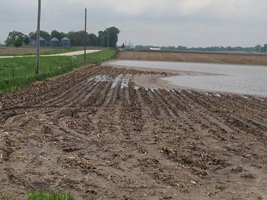 “Soybeans planted, but drowned out before they emerged,” writes Northey. That field is located near Rembrandt, towards the northwest corner of the state. Iowa Governor Terry Branstad yesterday declared a disaster emergency in 13 counties in central and northwestern Iowa due to flooding.
“Soybeans planted, but drowned out before they emerged,” writes Northey. That field is located near Rembrandt, towards the northwest corner of the state. Iowa Governor Terry Branstad yesterday declared a disaster emergency in 13 counties in central and northwestern Iowa due to flooding.
This time last year the corn was growing like crazy - nearly 90% emerged - before the water shut off and the drought came. Like Roseanne used to say, “It just goes to show you, it’s always something. If it’s not one thing, it’s another.”
Posted By Cindy May 7, 2013
 Nothing like a little snow in May to really slow down a planter!
Nothing like a little snow in May to really slow down a planter!
This photo from Minnesota was posted last week on the Case IH Facebook page. Despite the snow, Minnesota farmers did manage to get two percent of their corn crop in the ground last week, but they should have over half of it planted by now.
Nearly 50% of the crop nationwide should be planted by now in an average year, but only 12% was planted as of Sunday according to USDA. Last year at this time, nearly 70% of the crop was planted.
There was more progress last week than in recent weeks, even in states that saw more white stuff on the ground. Minnesota, Michigan, North and South Dakota, and Wisconsin all finally got a few points on the board after making no progress in the previous weeks. Illinois, Indiana and Iowa move up a few notches from 1-2% to 7-8%. But, again, all should be at or nearing the halfway point by now.
Emergence is far behind normal as well with 11 of the 18 top corn producing states showing no corn above ground yet. Just three percent of the crop has emerged compared to 29% last year and 15% average.
Not to worry yet, however. “It is still early in the planting season and slow progress at this point should not cause alarm,” said National Corn Growers Association President Pam Johnson, a grower in Iowa. “Modern farming technology has dramatically reduced the time needed for farmers to plant a large number of acres, and this means we can begin planting much later if need be.”
And a little cooperation from Mother Nature would help.
Posted By Cindy April 22, 2013
This spring is an example of what Gilda Radner’s character Roseanne Roseannadanna on the old Saturday Night Live shows used to say: “It just goes to show you, it’s always something! If it’s not one thing, it’s another!”
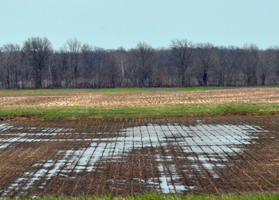 That’s what farming is all about when it comes to the weather. Last spring’s weather was picture perfect for planting and fast emergence - this year, not so much. By summer of 2012, the crops were wilting from heat and lack of moisture - now fields in some areas are flooding. If it’s not one thing, it’s another.
That’s what farming is all about when it comes to the weather. Last spring’s weather was picture perfect for planting and fast emergence - this year, not so much. By summer of 2012, the crops were wilting from heat and lack of moisture - now fields in some areas are flooding. If it’s not one thing, it’s another.
“Virtually no field work accomplished across the heart of the Midwest” this past week, according to USDA meteorologist Brad Rippey. Corn planting as of April 21 was just four percent nationwide, compared to 26% this time last year and 16% for the five year average. I took the photo in this post on Sunday off I-35 in DeKalb county Missouri. The Show Me State is showing 13% of the corn planted, compared to nearly 50% this time last year and about 30% for the average.
Illinois and Indiana managed to get 1% planted during the week, a far cry from last year when Illinois had 56% and Indiana had 43%. Ohio stayed stagnant at 1%, compared to over 30% this time last year. “Still haven’t seen a single field planted in some of the other major states,” said Rippey. That includes Iowa, Minnesota, Nebraska, North and South Dakota, and Colorado. But, normally those states should only be about 10% or less by now so there is still plenty of time to catch up.
The good news is that the moisture is much needed and that should be a big help whenever the crop does get in the ground. Warmer temperatures will also be helping the soil temps heat up a bit.
Posted By Cindy February 27, 2013
Most of us know where the drought hit the hardest last year, but it’s always more interesting to see it in living color.
The University of Illinois’ FarmDoc Daily did just that by comparing state corn yields last year with trend yields, showing how much yields were reduced in the most drought-stricken areas. You can click on the map below to see a larger version.

The map highlights how the lowest yields were in Kentucky (47 percent of trend) and Missouri (53 percent) and Indiana and Illinois came in at about 62 percent of trend. Much of the rest of Corn Belt saw yields around 75 percent of the trend line. Minnesota and North Dakota had yields close to trend, while most states in the Southeast had above trend yields. Georgia was 24% above trend and South Carolina was 31%, which would be great if those states were not generally ranked in the bottom half of corn growing states. New York and Maryland grow more corn than Georgia and South Carolina.
University of Illinois ag economist Gary Schnitkey, who did the map, says as bad as it was, the drought could have been worse.
“In some senses, though, the US dodged a bullet with the 2012 drought,” said Schnitkey. “Much lower total supplies would have resulted had the center of the drought occurred in eastern Iowa and northern Illinois. A center here would have impacted all of the corn-belt in a much worse way, potentially causing the western corn-belt to have as low of yields as the eastern corn-belt. As it actually occurred, Iowa and other western corn-belt state were not as badly hit as could have been the case.”
Read his summary here.
Posted By Cathryn February 22, 2013
Most consumers associate the cold, wintery weather that swept the country this week with staying indoors and keeping warm. Envisioning farming as a sunny day, warm weather gig, they often forget that farmers work to care for their land and livestock 365 days a year.
As snow and ice reign down on the roads, keeping kids home from school and adults stuck in traffic, many farmers are also vigilantly protecting their farms and their animals from the dangerous conditions.
Today, Corn Commentary features a guest blog post and a letter to the editor penned by CommonGround volunteers about how they care for cattle when the temperatures drop. Consumers worried about animal welfare can take heart. These farm women are taking action out of concern for their cattle, just like farmers across the country.
First, Sara Ross, a CommonGround Iowa volunteer, walks blog readers through what her and her husband do to prepare for a winter storm.
Preparing the Cattle for the Big Snowstorm
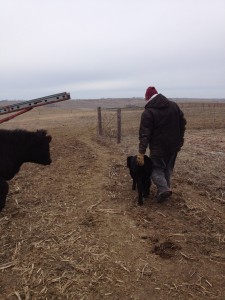
Sara and her husband, Kevin, prepare their cattle for an oncoming snow.
Everyone’s been talking about it all week…the big snow storm. First it was suppose to start Wednesday night then it got pushed back to Thursday morning then Thursday around noon. I’ve heard anywhere from 6-18 inches of snow forecasted. Normally it would be all fun and games to be snowed in, but since we have cattle, we had to get them prepared for the storm.
Kevin wanted to move the cows from across the road, where they were out on cornstalks, to our side of the road where they would have more protection and be easier to feed and water. We are a few weeks away from calving, but you never know when a big snow storm hits what will happen!
So, first thing this morning Kevin and I headed outside to get the cows moved to our side of the road.
To read the full post, click here.
CommonGround Nebraska volunteer Joan Ruskamp, who is well familiar with many of the questions consumers have about farming in the winter. She penned the editorial piece below To help answer questions she had seen in local papers.
Baby, it’s cold outside…but there’s still plenty to do on the farm
About this time every year, I begin to get surprised looks from people when I talk about all the activities happening on my family’s farm near Dodge, Neb. Together with my husband, we feed cattle and raise corn, soybeans and alfalfa. While the crops may not require a great deal of attention in the winter months, animal care on our farm is a top priority 365 days a year.
One of my many responsibilities includes walking through the cattle every morning, no matter the weather conditions, to make sure each animal is healthy. If an animal is sick and needs to be treated with antibiotics, we always adhere to label use under the supervision of our veterinarian. We also adhere to strict withdrawal times, or a set number of days that must pass between the last antibiotic treatment and the animal entering the food supply. And even though cattle have hair coats designed to handle living outdoors, in the cold winter months, we take extra care to make sure they are as comfortable as possible.
We provide extra bedding and windbreaks to help block the extreme cold. And in addition to shoveling our driveway during a snowstorm, we must remove or pile snow in the pens so that the cattle have dry places to lie down. We also must make sure that even during a snowstorm; the cattle are fed at their normal times with continuous access to water.
So, even though the winter weather might make you want to stay bundled up inside, know that farmers are braving the elements to make sure the animals are well cared for - because healthy animals equal healthy food for our families.
Sincerely,
Joan Ruskamp, farmer, Dodge, Neb.
Posted By Cindy February 20, 2013
The good news is that the overall drought area in the U.S. is continuing to decline from week to week. The bad news is that 2013 may be even drier than 2012 was.
The latest U.S. drought monitor shows less than 56% of the country in drought now, the lowest point since last July. “It’s also a decline of 5.36% since the beginning of the year and we’re down almost 10% from the peak in 2012,” said USDA Meteorologist Brad Rippey. “It is noticeable change but the problem is we’ve really been struggling to chip away at the drought right at the core.”
 “The forecast for this season is that in fact, we are predicting drier conditions,” said Dr. Roger Pulwarty, Director of the National Integrated Drought Information System at the National Oceanic and Atmospheric Administration, during a Senate Agriculture Committee hearing last week.
“The forecast for this season is that in fact, we are predicting drier conditions,” said Dr. Roger Pulwarty, Director of the National Integrated Drought Information System at the National Oceanic and Atmospheric Administration, during a Senate Agriculture Committee hearing last week.
Pulwarty emphasized that the big problem last year was the heat exacerbating the drought. “The major issue in the Midwest and the Southwest, Colorado Basin in particular, is that we are having back-to-back dry years and a third year of that puts our systems completely under stress,” he said.
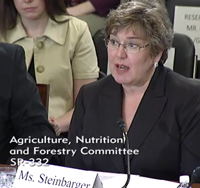 Indiana farmer Anngie Steinbarger was one of four producers on a panel who explained just how bad the drought was last year. “Our average yields are 150 bushels for corn,” she said, explaining that their decision to add an irrigation pivot on 35 acres of really sandy soil is what helped them get a crop last year. “Under the pivot was close to 200 bushels per acre and outside of the pivot was 10 bushels per acre,” said Steinbarger, adding that “The number one barrier to increasing our yields is lack of water.”
Indiana farmer Anngie Steinbarger was one of four producers on a panel who explained just how bad the drought was last year. “Our average yields are 150 bushels for corn,” she said, explaining that their decision to add an irrigation pivot on 35 acres of really sandy soil is what helped them get a crop last year. “Under the pivot was close to 200 bushels per acre and outside of the pivot was 10 bushels per acre,” said Steinbarger, adding that “The number one barrier to increasing our yields is lack of water.”
Irrigation helped the Steinbargers meet their contracts but it was crop insurance that helped them survive. “We paid a substantial premium for crop insurance and that decision is keeping us in business for the 2013 crop year,” Steinbarger said.
Posted By Cindy January 10, 2013
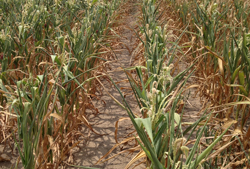 It is now official that 2012 was the hottest year on record, according to the latest National Oceanic and Atmospheric Administration (NOAA) State of the Climate report.
It is now official that 2012 was the hottest year on record, according to the latest National Oceanic and Atmospheric Administration (NOAA) State of the Climate report.
2012 marked the warmest year on record for the contiguous United States with the year consisting of a record warm spring, second warmest summer, fourth warmest winter and a warmer-than-average autumn. The average temperature for 2012 was 55.3°F, 3.2°F above the 20th century average, and 1.0°F above 1998, the previous warmest year.
According to NOAA, 2012 was record setting for 19 states, including several in the corn belt such as Illinois, Missouri, Nebraska and South Dakota.
While it was the hottest year on record, it was only the 15th driest year, with an average of 26.57 inches of precipitation nationwide. “At its peak in July, the drought of 2012 engulfed 61 percent of the nation with the Mountain West, Great Plains, and Midwest experiencing the most intense drought conditions.”
The drought is continuing over into the new year, with USDA this week designating nearly 600 counties in 14 states as primary natural disaster areas due to drought and heat, making all qualified farm operators in the areas eligible for low-interest emergency loans. In 2012, USDA designated 2,245 counties in 39 states as disaster areas due to drought, or 71 percent of the United States.
Bottom line - we still need lots of rain and some cooler temps would be nice too.
 As of Sunday, the corn crop was looking pretty good, according to meteorologist Brad Rippey. “The corn now 75% good to excellent on June 29, an increase of one percent from a week ago, eight points better than this time in 2013,” Rippey says.
As of Sunday, the corn crop was looking pretty good, according to meteorologist Brad Rippey. “The corn now 75% good to excellent on June 29, an increase of one percent from a week ago, eight points better than this time in 2013,” Rippey says.













